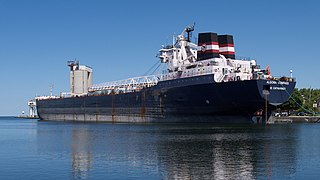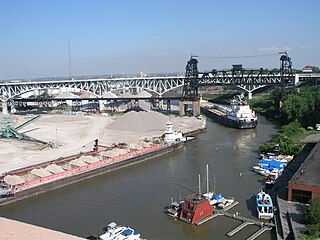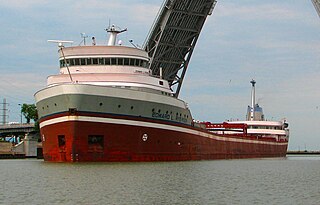The Defoe Shipbuilding Company was a small ship builder established in 1905 in Bay City, Michigan, United States. It ceased to operate in 1976 after failing to renew its contracts with the United States Navy. The site of the former company is now being developed for business and housing on the bank of the Saginaw River.
Quebecois was a lake freighter that served the Great Lakes, operating between ports in the United States and Canada. The vessel was launched in 1962 by Canadian Vickers Ltd of Montreal, Quebec, Canada. Used to carry grain and ore, Quebecois was built to the maximum dimensions allowed on the Saint Lawrence Seaway. The vessel entered service in 1963 and in 2012, the ship's named was altered to Algoma Quebecois. The ship was broken up for scrap at Port Colborne, Ontario, Canada in 2013.

MV Tim S. Dool is an Algoma Central-owned seawaymax lake freighter built in 1967, by the Saint John Shipbuilding and Dry Dock Co. in Saint John, New Brunswick. She initially entered service as Senneville when she sailed as part of the fleet of Mohawk Navigation Company. Senneville was the second lake freighter constructed with a single superstructure at the stern. In 1981, the ship was sold to Pioneer Shipping. That company sold the vessel to Algoma Central in 1994 who renamed the ship Algoville. The bulk carrier got her current name in 2008. Tim S. Dool is currently in active service on the Great Lakes of North America.
Algonova was a single-hulled oil tanker launched in 1969 as Texaco Chief for Texaco Canada Ltd. In 1986, the ship was renamed A. G. Farquharson. In 1995 the ship was sold to Imperial Oil. Purchased by Algoma Central in 1998, the ship was renamed Algonova. In 2007, Algoma Central sold the vessel to Belgrave Investors Corporation, which renamed the vessel Pacifico Trader. Helmer Business Incorporated acquired the vessel in 2012 and renamed the ship Great Portobello. The vessel is currently in active service.

Algorail was a lake freighter owned and operated by Algoma Central. The ship was built by Collingwood Shipyards in Collingwood, Ontario and was launched in 1967. The ship sailed on the North American Great Lakes and the Saint Lawrence Seaway delivering coal/coke, aggregates, slag, iron ore/oxides, salt, fertilizers, grain products, gypsum, quartzite, or sand. The ship was laid up in 2016 and sold for scrap in 2018.

John B. Aird was a self-discharging lake freighter/bulk carrier that was launched in 1983 and served on the Great Lakes and Saint Lawrence Seaway until 2017. The vessel was owned and operated by Algoma Central during that time, which had named the vessel for a former chairman of the Algoma Central Railway. Prior to the construction of Algoma Equinox in 2013, John B. Aird was the last vessel built for the company.

English River was a lake freighter and bulk carrier, launched in 1961 by Collingwood Shipyards of Collingwood, Ontario. In her initial years she carried bulk cargoes and deck cargoes to smaller ports on the Great Lakes and Saint Lawrence River watershed and estuary. In 1973, the vessel was converted into a cement carrier and carried mainly raw cement for the construction industry. The ship continued to operate until English River was removed from service and sold for scrap.

Baie Comeau is the fourth and last self-unloading lake freighter in Canada Steamship Lines (CSL) Trillium class. Like her sister ships, Baie St. Paul, Thunder Bay, and Whitefish Bay she was built in China, being launched in 2012 and entered service in 2013.

Algoma Progress was a self-unloading lake freighter and bulk carrier operating on the North American Great Lakes, owned by Algoma Central. Launched in 1968, the ship was originally named Canadian Progress and operated by the Upper Lakes Shipping. At launch, the ship was the largest self-unloading vessel on the Great Lakes. Canadian Progress was used to transport coal, iron ore, barley and road salt on the Great Lakes and Saint Lawrence Seaway. Canadian Progress ran aground twice, the first in 1985 and then again in 1988. In 2011, Upper Lakes Shipping sold its entire fleet to Algoma Central, which renamed the vessel Algoma Progress. In 2014, Algoma Progress was sold for scrap and broken up at Port Colborne, Ontario.

Algoma Compass, formerly Roger M. Kyes and Adam E. Cornelius, is a self-unloading bulk carrier built in Toledo, Ohio in 1973 for the American Steamship Company. The bulk carrier carried bulk cargoes throughout the Great Lakes and St. Lawrence Seaway. The vessel has earned a reputation as a "hard luck" ship, experiencing mechanical failures and groundings. In 2018, the ship was acquired by Algoma Central and put in service as Algoma Compass.
Algoma Navigator was a Canadian bulk carrier operated by Algoma Central. Like other bulk carriers, her potential cargoes included: coal/coke, aggregates, slag, iron ore/oxides, salt, fertilizers, grain products, gypsum, quartzite, or sand. The vessel was constructed by John Readhead & Sons in the United Kingdom in 1967 for the Cambay Steamship Company and launched as Demeterton. The vessel was enlarged in 1967 and sold in 1975 to the Upper Lakes Group which renamed the ship St. Lawrence Navigator. In 1979, the vessel was renamed Canadian Navigator after a rebuild. In 2011, the ship was sold to Algoma and became Algoma Navigator. In 2016, the bulk carrier was renamed Navi before being sold for scrap and broken up in 2016.

MV Edwin H. Gott is a very large diesel-powered lake freighter owned and operated by Great Lakes Fleet, Inc, a subsidiary of Canadian National Railway. This vessel was built in 1979 at Bay Shipbuilding Company, Sturgeon Bay, Wisconsin, and included self-unloading technology.

MV John J. Boland is a diesel-powered lake freighter owned and operated by the Buffalo-based American Steamship Company (ASC), a subsidiary of Rand Logistics. This vessel was built in 1973 at Bay Shipbuilding Company, Sturgeon Bay, Wisconsin. Initially named Charles E. Wilson, the vessel was renamed to its current name in 2000.

Algoma Buffalo, formerly Buffalo, is a diesel-powered lake freighter acquired by Algoma Central Corporation in 2018. This vessel was built in 1978 by Bay Shipbuilding Company at their yard in Sturgeon Bay, Wisconsin for the American Steamship Company and included self-unloading technology. The ship is 634 feet 10 inches (193.50 m) long and 68 feet (21 m) wide, with a carrying capacity of 24,457 tons deadweight (DWT), and is primarily used to ship road salt and construction goods. The vessel is currently in service.

Algosteel was a bulk carrier owned and operated by Algoma Central. The vessel was constructed in 1966 by Davie Shipbuilding at their yard in Lauzon, Quebec for Canada Steamship Lines and launched as A.S. Glossbrenner. In 1968, the vessel was acquired by the Labrador Steamship Company. In 1971, the ship was sold to Algoma Central. The vessel's name was changed to Algogulf in 1987 and to Algosteel in 1990. The bulk carrier primarily transported iron ore and grain along the Saint Lawrence Seaway and the Great Lakes. The vessel was taken out of service in April 2018 pending disposal and was scrapped in Aliağa, Turkey, in 2018 under the name Oste.
Algogulf was the third and last name of a bulk carrier launched in 1961, laid-up in 1999, and scrapped in 2002. The ship began her career in 1961 as J.N. McWatters, the second vessel of that name operated by the Misener Shipping Company. The bulk carrier was used to transport primarily grain and iron ore in the Saint Lawrence Seaway and Great Lakes. In 1991, the vessel was renamed Scott Misener by the company, the fourth of that name. In 1994, the ship was acquired by Algoma Central and renamed Algogulf, the second vessel of the name. The ship was laid up in 1999 and sold for scrapping in 2002.

The Interlake Steamship Company is an American freight ship company that operates a fleet on the Great Lakes in North America. It is now part of Interlake Maritime Services.

Algoma Provider was a Canadian lake freighter, which operated from 1963 to 2013 under the flag of several shipping lines. She was built to seawaymax dimensions at the Collingwood Shipyards in Collingwood, Ontario for Canada Steamship Lines. She was powered by a steam turbine, and was the company's last steam-powered vessel. Initially named Murray Bay, the ship was sold in 1994 to Upper Lakes Shipping, which renamed the vessel Canadian Provider. In 2011, Upper Lakes Shipping sold its entire fleet to Algoma Central, which renamed the lake freighter Algoma Provider. The vessel continued in service until 2013, when she was sold to be broken up for scrap. The ship was renamed Ovi for her journey to the scrapyard in Turkey. During her career, the ship carried bulk cargoes to destinations along the Saint Lawrence Seaway and Great Lakes.

Algosoo was a lake freighter constructed for Algoma Central in 1974 by Collingwood Shipbuilding in Collingwood, Ontario. The second ship of the name, Algosoo was the last lake freighter built in the traditional design for use on the North American Great Lakes, where the bridge topped a superstructure right in the ship's bow, and a second superstructure topped her engines, right in the stern. The vessel was used to transport bulk cargoes between ports on the Great Lakes. In 1986, the ship suffered a serious fire and in 1994, was forced to run aground to avoid a collision. Algosoo transported her last cargo in late 2015 and was sailed to the breaking yard at Port Colborne, Ontario in October 2016.

SS Edward L. Ryerson is a steel-hulled American Great Lakes freighter that entered service in 1960. Built between April 1959 and January 1960 for the Inland Steel Company, she was the third of the thirteen so-called 730-class of lake freighters, each of which shared the unofficial title of "Queen of the Lakes", as a result of their record-breaking length. She was not only the last steam-powered freighter built on the lakes but also the last one that was not a self-unloader. Since 2009, she has been in long-term layup in Superior, Wisconsin. She is one of only two American-owned straight deck lake freighters, the other being John Sherwin, built in 1958.















